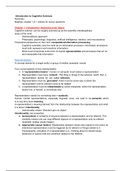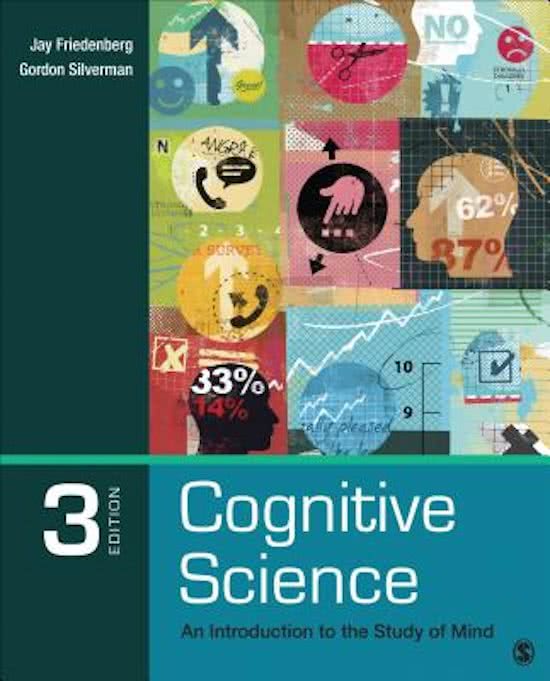Introduction to Cognitive Sciences
Summary
Material: chapter 1-5 + articles for bonus questions
Chapter 1: Introduction: Exploring Inner Space
Cognitive science: can be roughly summed up as the scientific interdisciplinary
study of the mind
- Interdisciplinary approach
- Philosophy, psychology, linguistics, artificial intelligence, robotics, and neuroscience
Theoretical perspective on the mind: computation/information processing.
- Cognitive scientists view the mind as an information processor. Information processors
must both represent and transform information.
- Mind must incorporate some form of mental representation and processes that act on
and manipulate that information
Representation:
A concept stands for a single entity or group of entities (example: words)
Four crucial aspects of any representation:
1) A “representation bearer”: human or computer must realize a representation
2) Representation must have ‘content’: The thing or things in the external world that a
representation stands for are called referents
3) Representation must be ‘grounded’: there must be some way in which the
representation and its referent come to be related
4) a representation must be interpretable by some interpreter, either the representation
bearer him or herself, or somebody else
Representation stands for something else = symbolic
Human mental representations, especially linguistic ones, are said to be semantic, which
is to say they have meaning
A representation’s meaning derived from the relationship between the representation and what
it is about: intentionality
- Intentionality means ‘directed upon an object’
Intentionality: two properties
1) Isomorphism or similarity of structure between a representation and its referent. This
similarity means one can map different aspects of a representation onto its referent
(example: analog visual images)
2) Appropriate causal relation: Relationship between inputs and outputs to the world; an
intentional representation must be triggered by its referent or things related to it.
Consequently, activation of a representation (i.e., thinking about it) should cause
behaviors or actions that are somehow related to the referent.
,Digital representations
sometimes also known as a symbolic representation, information is coded in a discrete way with
set values.
Digital mental representation: example language
- Verbal concepts seem to be the system of human symbolic representation
- The basic elements of written language are letters. These are discrete symbols that are
combined according to a set of rules.
- The combinations, or words, have meaning and are themselves combined into other
higher-order units, sentences, which also have semantic content.
- The rules by which these word elements are combined and transformed in language are
called syntax
Syntax constitutes the set of permissible operations on the word elements. It is the
elements themselves that are the mental representations
Analog Representations
represent information in a continuous way.
- Information in an analog system can theoretically take on any value not limited by
resolution.
- Resolution refers to the amount of detail contained in an analog representation (more
resolution = more information)
- Advantage of providing simple, direct solutions to some problems.
- They do however have a greater computational margin of error and because of the
smaller number of operations that can be
performed on them, are more limited for use in problem-solving
- Example: visual images - we represent visual information in an analog fashion
Dual-code hypothesis
The use of both digital/symbolic and image representations interchangeably (Paivio 1971)
- Example: “elephant”; concrete concept > we can form a visual image or a verbal
representation
- “Justice”; This is abstract, and although we could attach an image to it, such as that of a
court building, there is no unambiguous and unique identifying image > symbolic code
seems more appropriate
- Support for this theory; better recall for concrete concepts because two codes are better
than one
Propositional Representations
Propositional hypothesis; mental representations take the form of abstract sentence-like
structures. Propositions are good at capturing the relationships between concepts.
- Example: “Mary looked at John” specifies a type of relationship between Mary and
John, and that relationship can then be translated into either a verbal symbolic code, as
in the actual form of a sentence, or an image code
, - Neither visual nor verbal format: predicate calculus;
A predicate calculus is a general system of logic that accurately expresses a large
variety of assertions and modes of reasoning.
- Good: captures the essential logical structure of a complex idea independent of its actual
elements (any number of subj, obj, relations can be inserted)
not clear exactly how propositions are mentally instantiated or realized. They do,
however, serve as very useful hypothetical constructs
because they are concise and can specify virtually all of the possible relationships between
concepts.
Computation
Basically, the mind performs computations on representations
Tri-level hypothesis
Mental or artificial information-processing events can be evaluated on at least three
different levels (Marr, 1982)
1) Computational level: two tasks
- What exactly is this problem? What does this problem entail?
- Why isthis process here in the first place?
+ Idea of adaptiveness: human mental processes have evolved to enable humans to solve
problems (=evolutionary approach)
2) Algorithm; a formal procedure or system that acts on informational representations.
- What information-processing steps are being used to solve the problem?
put together at the algorithmic level/programming level
3) Implementational level (the hardware level)
- What is the information processor made of? What types of physical or
material changes underlie changes in the processing of the information?
> Overly simplistic, no respect for physical nervous system
The Classical and Connectionist Views of Computation
So far, we have been talking about computation as being based on the formal systems
notion. In this view a computer is a formal symbol manipulator
Formal: it is syntactic or rule-governed (example: language or mathematics), operate on
representations independent of the content of those representations
Symbol: form of representation
Manipulation: implies that computation is an active, embodied process that takes placeover
time. That is, manipulations are actions, they occur physically in some type of computing
device, and they take some time to occur
Classical view:
- knowledge is represented locally, in the form of symbols.
- processing occurring in discrete stages
, Connectionist view:
- knowledge is represented as a pattern of activation or weights that is distributed
throughout a network.
- processing occurs in parallel through the simultaneous activation of nodes
Interdisciplinary perspective
Philosophical approach
Primary method is reasoning:
- Deductive reasoning: application of the rules of logic to statements about the world.
Given an initial set of statements assumed to be true, philosophers can derive other
statements that logically must be correct
- Inductive reasoning: make observations about specific instances in the world, notice
commonalities among them, and draw conclusions
Psychological approach; the study of mental phenomena.
Psychologists apply the scientific method to both mind and behavior
Cognitive approach
part as a backlash against the behaviorist movement and its profound emphasis on behavior.
Cognitive psychologists placed renewed emphasis on the study of internal mental operations.
Computer as metaphor for the mind
+ Idea of modularity: Modules are functionally independent mental units that receive
inputs from other modules, perform a specific processing task, and pass the results
of their computation onto yet additional modules.
Neuroscience approach
general study of the brain and endocrine system and underlying brain mechanisms
- provides a description of mental events at the implementational level. It attempts
to describe the biological “hardware” upon which mental “software” supposedly runs.
Network approach
Mind is seen as a collection of individual computing units. These units are connected to one
another and mutually influence one other’s activity via the connections. Although each of the
units is believed to perform a relatively simple computation
- Connectivity = complexity
Evolutionary approach
Natural selection (Darwin) holds that adaptive features enable the animals that possess
them to survive and pass
these features on to future generations. The environment in this view is seen as selecting from
among a variety of traits those that serve a functional purpose.
- applies selection theory to account for human mental processes
Linguistic approach






